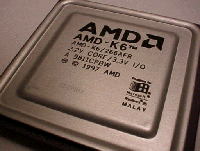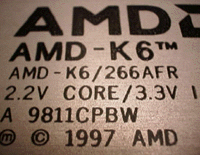What makes the K6/266 different from the original members of the K6 line that made their debut on April 2 last year? First of all, the die of the K6/266 (the chip itself, not the external casing) is manufactured using a 0.25 micron circuit size, compared to the 0.35 micron die size of the previous K6 chips. Not only does this allow the K6/266 to run at higher clock speeds, opening the world of Socket-7 Overclocking to an entirely new universe, but this die shrink virtually eliminated the heat problems the original K6's gave users, especially when overclocking. |
 |
| This die shrink, walking hand in hand with the newly lowered core voltage of the K6/266 (2.2v compared to the 2.9v setting for the 166/200MHz K6's and the 3.2v setting for the 233MHz K6's) make the 266 everything the original K6 should have been...and then some. |  |
The K6/266 accepts clock multipliers from 2.0x up to 5.0x, with some 266's being reported as even supporting the 5.5x clock multiplier. Using the 66MHz bus speed, and the 2.2v core voltage setting the 266 can be taken as high as 300MHz...everything else becomes a little more complicated, so let's eliminate some of those complications.
Overclocking the K6/266 deviates from the conventional overclocking methods for Socket-7 processors. With the old K6's or the Pentium MMX you could simply take the core voltage up to about 0.6v above the recommended levels and achieve greater stability, provided that you could cool the chip properly. This is definitely not the case with the K6/266. All voltages above 2.4v - 2.5v should be considered unusable with the K6/266, and you must keep in mind that just because a motherboard states that it has a 2.2v voltage setting it doesn't necessarily feed the processor 2.2v, rather something *around* that number. This is where the quality of a motherboard can really come into play, your decision to skimp on your motherboard to save a few bucks may just come back to haunt you.
300MHz can be achieved without increasing the core voltage of your CPU much (if at all), at most you will probably have to take the CPU up to 2.3v but no more. Booting at 333MHz (66 x 5.0) is a bit of a trick, it requires a core voltage of a little more than 2.3v, therefore the key to running your K6/266 at 333MHz is the use of a 2.4v core voltage setting. All of these settings take for granted that you don't have the 75, 83.3, or 100MHz bus speeds at your disposal...if you do...then things start to get interesting.










0 Comments
View All Comments